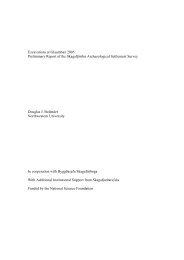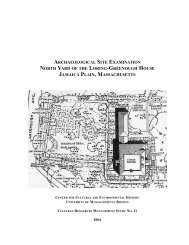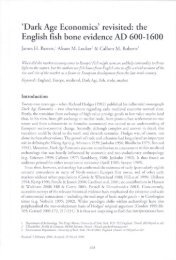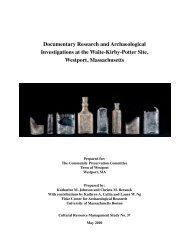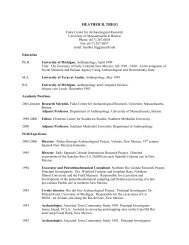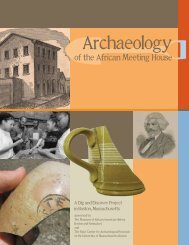Piracy in Late Roman Britain: A Perspective from the ... - Fiske Center
Piracy in Late Roman Britain: A Perspective from the ... - Fiske Center
Piracy in Late Roman Britain: A Perspective from the ... - Fiske Center
You also want an ePaper? Increase the reach of your titles
YUMPU automatically turns print PDFs into web optimized ePapers that Google loves.
PIRACY IN LATE ROMAN BRITAIN: A PERSPECTIVE FROM THE VIKING AGE<br />
341<br />
Importantly, o<strong>the</strong>r booty will not feature <strong>in</strong> <strong>the</strong> archaeological record. An additional attraction<br />
of <strong>the</strong> monasteries lay <strong>in</strong> <strong>the</strong> fact that <strong>the</strong>ir farms were well stocked with agricultural products.<br />
Whilst of comparatively low value for its volume, such goods were essential if a raid<strong>in</strong>g group<br />
were to survive <strong>the</strong>ir journey home. Given <strong>the</strong> probable summer tim<strong>in</strong>g of <strong>the</strong> early phase of<br />
raids, it is unlikely that <strong>the</strong> Vik<strong>in</strong>gs destroyed many harvests.<br />
Slave-tak<strong>in</strong>g was ano<strong>the</strong>r major and lucrative activity <strong>from</strong> <strong>the</strong> outset.18 The first attack on<br />
L<strong>in</strong>disfarne <strong>in</strong> A.D. 793 <strong>in</strong>volved <strong>the</strong> abduction of monks, and it is perhaps a comment on<br />
<strong>the</strong> value of human captives that <strong>the</strong>y were taken whilst many of <strong>the</strong> monastery's treasures<br />
were left unsca<strong>the</strong>d. Slav<strong>in</strong>g was a regular feature of Vik<strong>in</strong>g warfare, and Irish annals record<br />
several <strong>in</strong>stances where hundreds of captives of both sexes were taken at a s<strong>in</strong>gle time; whilst a<br />
proportion may have been ransomed, a great many were dest<strong>in</strong>ed for <strong>the</strong> slave markets. The Life<br />
of St F<strong>in</strong>tan of Rhe<strong>in</strong>au <strong>in</strong>dicates that captives were be<strong>in</strong>g sold <strong>in</strong> <strong>the</strong> Scand<strong>in</strong>avian homeland,<br />
whilst locations such as Dubl<strong>in</strong> were also important centres of <strong>the</strong> slave trade.19<br />
VIOLENCE<br />
The historical record provides a strong image of Vik<strong>in</strong>g depredations, and despite recent research<br />
that modifies our understand<strong>in</strong>g of <strong>the</strong>ir impact, <strong>the</strong>re is no doubt of <strong>the</strong> reality of attacks, or <strong>the</strong><br />
genu<strong>in</strong>e shock expressed by contemporary chronicles.<br />
The traditional image of Vik<strong>in</strong>g raid<strong>in</strong>g is of an activity accompanied by violent destruction.<br />
Burn<strong>in</strong>g is a consistent feature <strong>in</strong> historical accounts, and Lucas assembles a large volume of<br />
textual evidence for <strong>the</strong> burn<strong>in</strong>g of Irish churches dur<strong>in</strong>g <strong>the</strong> medieval period.20 However, Lucas<br />
notes that <strong>the</strong> culprits were as often native forces as <strong>the</strong>y were foreign pirates, and br<strong>in</strong>gs to our<br />
attention <strong>the</strong> fact that <strong>the</strong> era was not one of just Scand<strong>in</strong>avian violence. For example, prior to<br />
<strong>the</strong> onset of Vik<strong>in</strong>g raid<strong>in</strong>g, civil war <strong>in</strong> Northumbria is alleged to have led to <strong>the</strong> robb<strong>in</strong>g of<br />
church lands (see <strong>the</strong> History of St Cuthbert). Similarly, dur<strong>in</strong>g <strong>the</strong> tenth-century wars aga<strong>in</strong>st<br />
<strong>the</strong> Danelaw <strong>the</strong> West Saxons were responsible for direct assaults on <strong>the</strong> Church, most famously<br />
at Ripon <strong>in</strong> A.D. 948.21 Authors such as Alcu<strong>in</strong> asserted that <strong>the</strong> s<strong>in</strong>s of <strong>the</strong> people had brought<br />
down <strong>the</strong> hea<strong>the</strong>n assault on England: attribution of blame is not, <strong>the</strong>refore, as simple as it might<br />
first seem.<br />
DESTRUCTION<br />
EVIDENCE FOR VIKING RAIDING<br />
There is some archaeological evidence to support <strong>the</strong> documentary assertions of violence dur<strong>in</strong>g<br />
<strong>the</strong> eighth to tenth centuries, but it is far less than might be thought. The site of <strong>the</strong> monastery<br />
at Tarbat, on <strong>the</strong> east coast of Scotland, is one prom<strong>in</strong>ent example. Here, a destruction layer<br />
<strong>in</strong> one part of <strong>the</strong> site attests to an episode of widespread burn<strong>in</strong>g, and conta<strong>in</strong>s charcoal,<br />
ash, nails (<strong>in</strong>terpreted as <strong>the</strong> rema<strong>in</strong>s of structures), and fragments of religious sculpture that<br />
appear to have been deliberately smashed. The destruction of this sculpture surely suggests an<br />
ideological element to <strong>the</strong> violence. Excavations under <strong>the</strong> church have revealed 67 skeletons,<br />
57 of whom were male and several of <strong>the</strong>m hav<strong>in</strong>g suffered blade <strong>in</strong>juries. Carbon dates are as<br />
18 Pelteret 1995.<br />
19 Holm 1986.<br />
20 Lucas 1967.<br />
21 Hadley 2000, 284-6.



